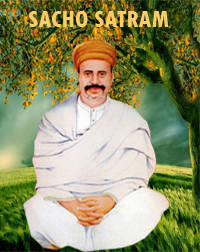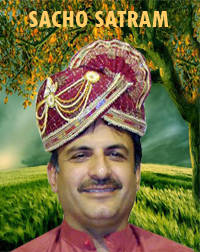In his inspiring Satsang on the third day (27th October 2024) of the auspicious birth anniversary celebrations of Shahanshah Satguru Sai Satramdas Saheb, Hazir Swaroop Sai Sadhram Saheb highlighted that the value of our lives isn’t measured by the number of years we live, but rather by how much time we dedicate to performing good deeds throughout our lives.
Shahanshah Satguru Sai Satramdas Saheb was born with a spiritual elevation, exemplifying deep moral integrity and a profound sense of divinity—traits that are truly rare.
He was born as a spiritually elevated being and departed from his mortal body in the same elevated state. Nothing diminished his divinity.
It is fascinating that on the day of the birth of the great Sant Shahanshah Sai Satramdas Sahib, on October 25, 1866, his father, the revered Sant Sai Khotaram Saheb, entered into deep meditation for three consecutive days. On the third day, October 27, 1866, when the highly esteemed Aad Satguru Sai Khotaram Saheb opened his eyes, he lovingly took his three-day-old son, Sant Sai Satramdas Sahib, in his lap. Aware of his son’s greatness and the purpose of his birth, Aad Satguru initiated him with the Divine and sacred NAAM and Sant Sai Satramdas Saheb accepted the divine Naam with reverence, bowing his head in respect before his esteemed father.
Entering samadhi is a lengthy journey. The practices of Naam, dhyan, and simran are essential steps that help a person become worthy of achieving samadhi.
Sai Khotaram Saheb entered into Samadhi upon the birth of his beloved son, Shahanshah Sai Satramdas Saheb, emphasizing the remarkable spiritual power of Shahanshah Satguru Sai Satramdas Saheb. This also reveals the depth of their internal connection to one another.
Aad Sadguru Sai Khotaram Saheb initiated Sant Sai Satramdas Sahib with the sacred NAAM on October 27, 1866. Shahanshah Satguru received this holy NAAM when he was just three days old, which is why we celebrate October 27 each year as an auspicious day of the sacred NAAM. When blessed with NAAM, one can navigate the currents of life with ease.
One day, some sadhus were passing through a jungle and came across a cemetery containing the samadhis of local people. They noticed that the dates of birth and death engraved on the samadhis were very close together.
The sadhus were astonished when they encountered some locals who were neither very young nor elderly. This surprised them, as the lifespans inscribed on the samadhis indicated that the inhabitants of the area typically died at a young age. While the sadhus were contemplating that remarkable place, some local residents noticed them and approached. The locals invited the sadhus to their temple for a meal.
The sadhus accepted the locals’ invitation, and upon arriving at the temple, they were surprised to see people of all ages gathered there. Some were elderly, others were young, and there were even children present.
The sadhus expressed their surprise to the locals and inquired why the ages inscribed on the samadhis of the deceased indicated such short lifespans—some lived for just 8 years, others for 10, and some even less—while they observed elderly individuals present in the temple.
The locals explained to the sadhus that they were very straightforward about their daily actions. They shared that they kept a clear account of their, business karmas and daily activities. They explained that they calculated the number of years they spent doing good deeds, such as Naam, Jaap, Simran, meditation, and other seva activities to please God. They clarified that the ages inscribed on the samadhis of the deceased reflected the total years those individuals engaged in good practices and meditation, rather than their actual lifespan.
The locals stated that they do not account for the years spent engaging in wrongdoing, wasting time, gossiping, or pursuing selfish activities. They viewed those years as unproductive.
They considered the years truly lived to be those spent in selfless service, Naam, Dhyan, and Simran.
Saijan further explained that the valuable time we spend in life represents the years we truly live, while the time we waste equates to the life we have not lived. Hazir Swaroop Sai Sadhram Saheb remarked that the life of Sai Satramdas Saheb exemplified a pious and pure existence, beginning with Naam, Jaap, Simran, and Sat Karamas.
People often do not live their lives to the fullest and waste time on inappropriate activities, but Shahanshah Satguru Sai Satramdas Saheb embraced life completely. Every moment of his existence was meaningful.
We must make our lives successful, and this is achievable only through regular practice of meditation, Naam, Jaap, and Simran. They say death is very painful. The pain is likened to the sting of thousands of scorpions. This comparison is illustrated by the story of a mother scorpion, who, after giving birth to many young, carries them on her back for months. As they cling to her, they bite her continuously, leaving her with nothing not even her bones.
The saying about scorpions is connected to the concept of a painful death, as in this story, scorpions symbolize our negative karmas. The belief is that the more bad karmas one has, the more painful the experience of death will be. Our own Karmas are the reason of our painful death.
Hazir Swaroop Sai Sadhram Saheb beautifully articulated that to be truly blessed in life, it’s essential to dedicate time to gain knowledge and wisdom from our Satguru and his teachings. It is important to honor the one from whom we learn by offering them a higher seat while we sit humbly at the feet of our Guru or Master. The gaze of a master and Satguru flows like water, always moving downwards. By giving a higher seat to our Satguru or master, we can effortlessly and positively receive the knowledge and wisdom they impart.
To further enlighten the devotees about acquiring knowledge and wisdom, Saijan beautifully shared a story about a king who desired to learn something new. He appointed a pandit to teach him, but after many months, the king still struggled to grasp what should have been learned in a week or two. Concerned, the king questioned the pandit about the reason for his difficulty, wondering if he himself lacked perfection or if the pandit was at fault. The pandit explained that neither of them was lacking in perfection; rather, it was the king’s approach to learning that was imperfect. The pandit advised the king that a learner should always sit lower than the teacher, who should occupy a higher seat, as this arrangement allows the student to better receive and understand what the teacher, guru, or master is imparting.
Pandit ji explained to the king that because he was always seated on a throne higher than Pandit ji’s seat, he struggled to grasp the teachings being shared. After thoughtfully considering this explanation, the king began to sit at a lower level and offered a higher seat to Pandit ji. As a result, he was able to learn what he wanted from Pandit ji within just a few days, a process that had previously taken him much longer.
Hazir Swaroop Sai Sadhram Saheb expressed that the blessings of Satguru flow like water, and we should always seek these blessings through regular practice of Naam, Simran, meditation, and the divine remembrance of Satguru or Parmatma. The significance of consistently remembering Satguru or Parmatma through Naam, Jaap, and Simran is that it helps us avoid being caught red-handed. This means that when Yamraj, the God of death, comes to take our life, we should be in a state of divine remembrance, free from any wrongdoing at that moment. That’s why Saijan emphasizes the importance of regularly engaging in Naam, Jaap, and Simran to purify our lifestyle and steer clear of negative karmas.
Constantly reciting Naam jaap transforms into Ajapa jaap, which flows eternally without ever stopping.
For example, if we freshen up and express our gratitude to Parmeshwar or our Satguru before going to bed, and then begin our Naam Jaap as we fall asleep, we may find that when we wake up in the morning, the Jaap we initiated before sleeping has continued in our mind. Continuous Jaap within us transforms into Ajapa Jaap, which cleanses all our karmas.
To further explain the science and benefits of Naam Jaap and Simran, Saijan shared a story about a sadhu who was walking through a jungle when he came across a celebration. As he approached, he realized that a ghost was celebrating the wedding of his daughter. The sadhu inquired about the groom, and the ghost replied that the bridegroom would arrive the next day, as he was still alive in human form but very ill and near death.
The ghost explained that the boy had consistently lived contrary to human values and had all the bad habits. This was the reason he would be reborn as a ghost after his death, eventually marrying his daughter. The ghost also mentioned the boy’s name, his father’s name, and the place they were from.
After leaving the jungle, the sadhu traveled to the place where the boy, whom the ghost wanted to marry his daughter, lived and inquired about his residence. He met the boy’s father and asked about his son. The father clearly explained the boy’s condition to the sadhu, informing him that his son would not live beyond one day. The sadhu then expressed his desire to meet the ailing boy.
The boy’s father led the sadhu to where his son was. After greeting the boy, the sadhu explained that since his health had deteriorated so much and there was little hope for him to live much longer, it would be best for him to spend his remaining time reciting the sacred Naam and preparing for a better afterlife. The boy agreed, and the sadhu initiated him into the pious Naam. The boy began to recite the Naam continuously and passed away the following day.
After leaving the boy’s home, the sadhu returned to the jungle and observed that all the ghosts had ceased their wedding celebrations and were feeling dejected. When he inquired about their sadness and the reason for stopping the festivities, the king of the ghosts, whose daughter was to be married, expressed his anger towards the sadhu. He explained that the boy they had been waiting for had attained moksha because the sadhu had given him the sacred Naam, preventing him from living as a ghost.
That was the power of the NAAM, as Saijan enlightened the devotees.
Our attachments and karmas are uprooted through the regular practice of Naam Jaap.
Saijan said that rather than judging others, we should focus on monitoring our own karmas. We should take time each day to reflect on our actions, both good and bad, and keep track of our own deeds.
We should also purify our breaths through Naam Jaap and Simran. The time we dedicate to chanting is the true time we spend living life to its fullest; the rest of the time is simply wasted. This is why we seek the guidance of our Satguru—to learn how to live our lives fully and meaningfully.
Our good karmas are what earn us respect in life. For instance, we naturally show respect to our elders, those in higher positions, or individuals who have built a positive reputation in society. If we reflect on this, we realize that it is their good deeds that we respect. When someone achieves success through hard work, virtuous actions, and intelligence, they earn respect for what they’ve accomplished. It’s not their identity, but the deeds they have performed, that earn them this respect. Ultimately, what truly matters is our karmas.
Therefore, it’s important to value our actions, and to think and act with care. If we fail to perform good deeds and instead waste our energy and time on wrongdoings, our luck will not favor us, and we will not earn the respect we deserve. There’s a saying that when a person starts failing in everything they do, it’s a sign that their luck has turned away.
With the blessings of our Satguru, all the negative karmas from our past lives are erased, our fortunes improve, and we begin to progress and thrive in life.
Sure! Here’s a rephrased version:
Saijan shared a story about a man who was deeply arrogant and never showed respect to others. Though he was well-established and financially comfortable, he avoided interacting with people, convinced that no one could match his status.
One day, Shahanshah Satguru visited a place near his home. The man happened to see the Satguru and was instantly captivated by his divine presence. Unable to resist, he fell at the feet of Shahanshah Satguru and confessed that he had always believed no one was as great as he was, and he had never bowed to anyone. However, after witnessing the divine sight of Shahanshah Satguru, his ego dissolved, and he found himself humbly bowing before the Satguru’s holy feet. He then earnestly asked Shahanshah Satguru Sai Satramdas Saheb to reveal the reason why he felt such deep reverence for Saijan and why his heart had been so deeply moved by the divine sight of the Satguru.
Shahanshah Satguru gently explained that our actions (Karmas) have a profound impact on the form of life we are born into. Saijan shared that in the man’s previous life, he had been a fierce and wild animal, showing no compassion for any living being. However, one day, as he was passing through an area, he came across a group of baby animals. The little ones were hungry and suffering from the intense heat of the sun, which made them uncomfortable. Despite his wild nature, this former beast stood still, casting his shadow over them to offer them relief, until their parents arrived and took them to a safer place. Shahanshah Satguru then told him that this single act of kindness had transformed his destiny, and as a result, he was born as a human being.
Saijan reflected that while many of his tendencies still mirrored those of the wild animal he once was, the act of casting his shadow over the babies—bringing them comfort and calm—had also cast a shadow of peace over his own life. His inner self had been transformed, and he was rewarded with divine blessings and contentment as a result of the compassion he had shown in his past life as a beast.
Shahanshah Satguru told the egoistic man that the choice was now his: whether he wanted to transform himself by seizing this moment and dedicating himself to selfless service (seva), Naam, and Simran. If he embraced this spiritual path, his life would be filled with glory, and all the disgrace he had known would come to an end.
The man bowed his head before the holy feet of Shahanshah Satguru Sai Satramdas Saheb, seeking his blessings. In response, Saijan blessed him with the sacred Naam. Embracing a life of devotion, the man began to chant the Naam regularly and silently, engaging in Jaap and Simran. He caused no harm to anyone, living a life of peace and selflessness. With a compassionate heart, he consistently aided those in need and supported the people of his city. As he grew older and fell ill, the people of the city gathered to pray for his health, asking Shahanshah Satguru to bless him with well-being and happiness.
The benefit of seeking refuge in our Satguru’s guidance and transforming our lifestyle through the regular practice of Naam, Jaap, Simran, and Dhyan is that the curses accumulated from our past negative karmas are transformed into blessings, leading us to greatness in life.
Hazir Swaroop Sai Sadhram Saheb emphasized that we must make our lives meaningful by living with integrity and incorporating Naam, Jaap, and Simran into our daily routine. This will erase the impact of our previous bad karmas and help us lead a pious and fulfilled life.
We should make our lives meaningful through good karmas. While we seek the blessings of our Satguru and Parmatma, we must avoid the sting of scorpions. Just as a scorpion is harmed by its own offspring, we too suffer from the consequences of our own bad karmas. Nothing and no one can destroy us; we bring destruction upon ourselves through our own actions.
We must always reflect on ourselves and keep track of our own actions. While we tend to remember what others have said to us and often struggle to forget the curses, hurtful words, and actions directed our way, we rarely account for our own behavior. It’s important to remember that speaking harshly to others or wronging them contributes to our own misery. The harm we cause others leads them to develop hatred toward us, and we are responsible for stirring those negative feelings through our own actions. Ultimately, we suffer because of the wrongs we have done to others.
In both cases, we are affected by our actions. If we cultivate good thoughts and love in others, they will remember us with affection and positivity, and in return, we will receive blessings for the good karma of filling their hearts with positive thoughts. However, if we sow hatred and negativity in someone’s mind, we will face the consequences of our bad karmas, as we are responsible for filling their mind with negativity and animosity.
Saijan drew the attention of his devotees to a crucial topic—depression and anxiety. He shared that, according to recent surveys, nearly 70% of people are suffering from these conditions, with the primary cause being their negative thoughts. Most people spend their time thinking about others, neglecting to focus on themselves. They waste energy analyzing others and their actions, yet rarely take the time for self-reflection or introspection.
Saijan emphasized that if we decide to stop wasting our thoughts and energy on others, and instead focus on keeping an account of our own actions, we can free ourselves from the burden of anxiety and depression.
Saijan enlightened his devotees with the example of a scorpion, which is stung by its own offspring (representing karmas), and a mother snake that devours her own babies, knowing they will grow up to harm others. This serves as a powerful reminder that the actions we create or nurture can sometimes turn against us. Just as the snake instinctively eliminates its own young to prevent them from causing harm, we too must face the consequences of our own deeds and karmas.
Our karmas shape the course of our lives. Good karmas bring honor and glory, while bad karmas lead to disgrace. This is why it is essential to seek refuge in our Satguru and follow His guidance through regular Naam, Dhyan, and Simran. When we engage in daily Naam Jaap, our mind becomes illuminated, preventing us from committing wrong actions. We become more aware and vigilant, helping us avoid harmful or negative deeds.
Hazir Swaroop Sai Sadhram Saheb beautifully reminded his devotees that October 27th, 1866, was a truly auspicious day. On this day, Shahanshah Satguru Sant Sai Satramdas Saheb received the sacred Naam Deeksha from his highly revered father, Sant Sai Khotaram Saheb.
The birth of Shahanshah Satguru Sant Sai Satramdas Saheb was extraordinary and spiritually significant.
After receiving Naam Deeksha from his revered father on the third day of his life, which was October 27th, 1866, he began to accept his mother’s milk. This remarkable episode from the life of Shahanshah Satguru Sai Satramdas Saheb emphasizes the profound importance of Naam Jaap. Not a single moment of his life was wasted; every moment was immersed in the divine act of Naam Jaap, and he lived a life that was both meaningful and purposeful.
The one whose birth led his father, a revered Sant, to enter samadhi; whose presence spread joy and smiles everywhere; and who imparted the profound importance of Naam Jaap to the entire world—such a great Sant’s life is eternal.
Shahanshah Sant Sai Satramdas Saheb continues to live among us today, through the timeless teachings he shared during his lifetime.
Sacho Satram



